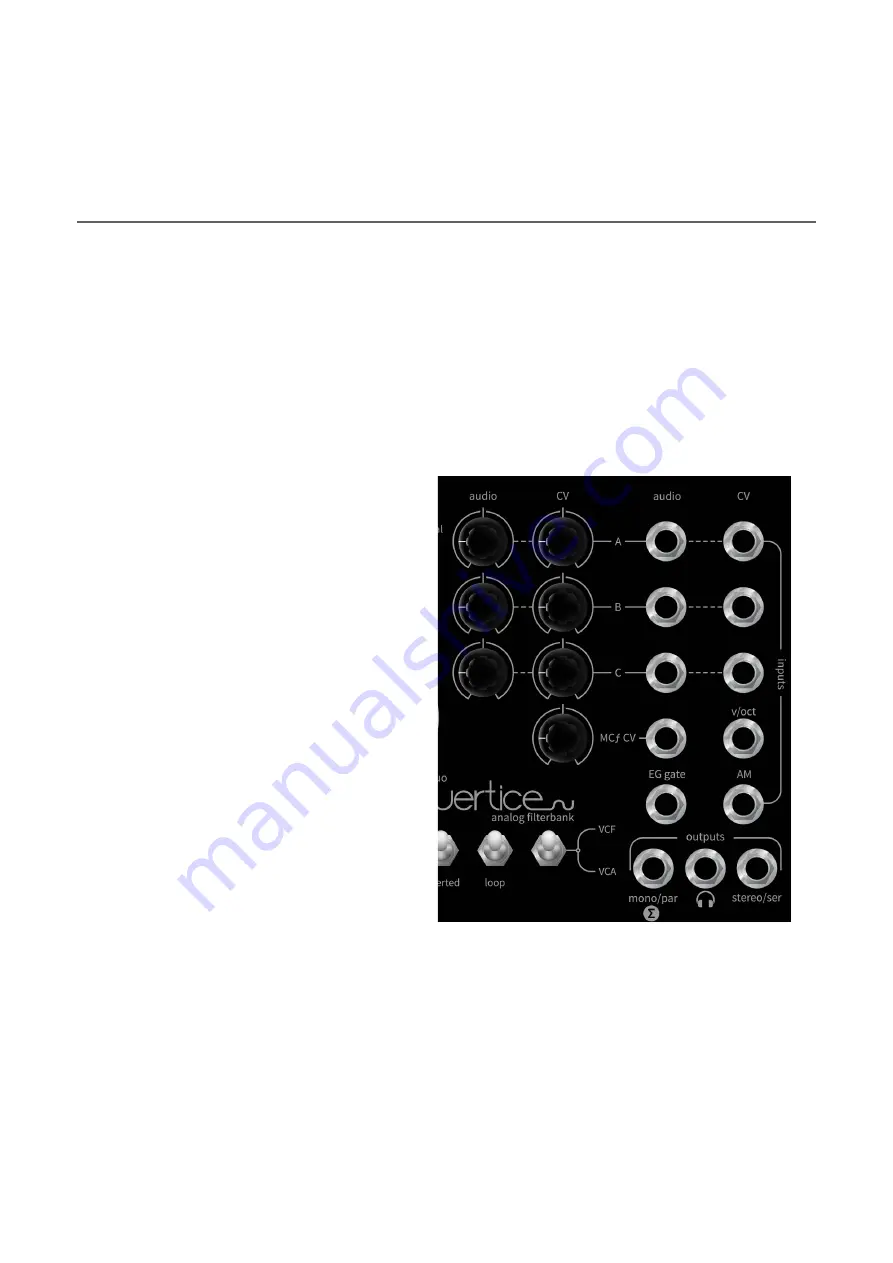
THE COMPONENTS
[
17
]
THE COMPONENTS
the Connections Panel
The VERTICE Analog Filterbank is externally composed of:
•
the
Inputs and Outputs section, which hosts most of the playing connections the VERTICE can allow. They
are here to easily "plug-and-play" your ideas
•
the
Main section, which is the place where you can really play with it
•
the
Rear panel where you can find serial number, rear ouput ports, power socket and fuse replacements.
Follow the detailed explanations of these sections.
The INPUTS and OUTPUTS on the front panel
It's the right side of the machine and provides several ports for Audio and CV managing, properly labeled.
In the nine Input ports you can respect their designated functional domain or try some more creative patches.
An oscillating CV is certainly a CV but it's also an
oscillation... you can try to plug it into the “wrong
hole”, generally it is not dangerous for the VERTICE’s
health. However try to use only “musically known”
signals, avoiding e.g. direct 380VAC or radioactive
gamma ray. Higgs boson also should be avoided.
The two OUTPUT ports also can be “mistaken”.
The natural destination is the
MONO
or the
summing
PARALLEL
out for the first one, and the
STEREOPHONIC
or
SERIAL
for the second one. Later
in this manual all the nuances of the two/three/
four modalities are fully investigated. For now treat
them as your intuition suggests, like i.e. "Parallel =
sum of signals, Serial = sequence of signals".
Reference Labelling
In addition to this quick description here you can
find some reference terminology valid of course
throughout the labels on the whole Filterbank and
frequently used in this manual:
•
A / B / C
: is related to the three filterboards,
heart of VERTICE, in left to right sequence
•
Cf
is the acronym of Cutoff Frequency
•
MCƒ
: this label indicates the
MASTER CUTOFF
frequency control hosted in the middle of the
front panel
•
Emphasis
mean Resonance, a controllable feedback that preeminently define the filter character.
•
CV
is the acronym of Control Voltage. In the synthesisers world this way of control something else came
before the MIDI age, when everything was to be controlled by simple variations of voltage at a given point
of the circuit. This method, exept for some accurate situations like VCOs exponential converters, was not
so much precise, using a large scale of values (0/+5V or even +/-10V). This lack of precision was not a big
problem since the analog subtractive synthesis was (and still be) very coarse and inaccurate, THEN creative.
Errors make us artists.
Inappropriate precision make us instruments. My CD player play the same virtuoso solos of Vivaldi exactly
the same at every listen. No-one real human can do that. I call it lucky, and it isn't a problem at all. :)
Содержание Vertice
Страница 1: ...USER S MANUAL...
Страница 2: ......
Страница 5: ...Dedicato a Walt Bruno e Lorenzina con immenso amore Stefano...
Страница 68: ...Ratio et Cogitatio Unicam Fidem Sunt...
Страница 69: ......
Страница 70: ......






























